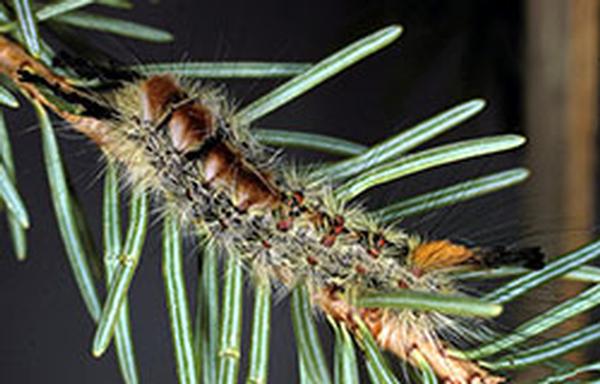The Douglas-Fir Tussock Moth an Invasive Pest
Have you noticed that your trees have shriveled and started to turn a reddish-brown color? You may have an infestation of the Douglas-Fir Tussock Moth. The first signs of attack usually appear in late spring (around bud break). Here is what you need to know and the treatment options that are available:
WHAT IS IT?
A young tussock moth caterpillar can be a green/black-like color with long body hairs that produce brightly colored tufts of hair as they grow larger. A mature larva is about 1.2 – 1.4 inches long and has a gray to brown body and a shiny black head. They have two, prominent, tufts of black hair that come out from their head; a similar tuft sticks out from the rear of the body.WHERE ARE THEY FOUND?
In a forest setting, the tussock moth prefers the Douglas-fir tree although it can occasionally be found on true fir trees or spruces. In an urban setting, blue spruce trees are attacked.Since the female moths are flightless, they rely on wind to move the young larvae to initiate new infestations.LIFE CYCLE
The tussock moth has a one-year life cycle. It spends the winter months as an egg and the eggs hatch in the spring, typically in late May (around the bud break time). The caterpillars start out feeding on the newer foliage causing the partially consumed needles to turn brown. The older caterpillars, will move to older needles as the more tender and desirable needles are eaten.DAMAGE
In the late spring, you may start to notice the first signs of an attack by the tussock moths. The young larvae begin feeding on the current year’s foliage causing it to turn a reddish-brown color. The damage begins at the top of the tree and outward branches and works its way to the inner branches and downward as the season progresses.Severe defoliation can lead to the death of the tree or make the trees more susceptible to an attack by a bark beetle.NEXT STEPS?
While the tussock moth does have some natural predators including birds, it is best to have your trees assessed and to create a treatment plan with a Plant Health Care technician. Contact the team at Splintered Forest to get a free consultation today! *DID YOU KNOW?
The hairs on the tussock moth larvae can cause an allergic reaction to humans known as Tussockosis. A skin irritation is most common, but some can experience rashes, sneezing or watery eyes. If you suspect you have come in contact with the larvae, wash after your exposure and always try to avoid handling the larvae.
A young tussock moth caterpillar can be a green/black-like color with long body hairs that produce brightly colored tufts of hair as they grow larger. A mature larva is about 1.2 – 1.4 inches long and has a gray to brown body and a shiny black head. They have two, prominent, tufts of black hair that come out from their head; a similar tuft sticks out from the rear of the body.WHERE ARE THEY FOUND?
In a forest setting, the tussock moth prefers the Douglas-fir tree although it can occasionally be found on true fir trees or spruces. In an urban setting, blue spruce trees are attacked.Since the female moths are flightless, they rely on wind to move the young larvae to initiate new infestations.LIFE CYCLE
The tussock moth has a one-year life cycle. It spends the winter months as an egg and the eggs hatch in the spring, typically in late May (around the bud break time). The caterpillars start out feeding on the newer foliage causing the partially consumed needles to turn brown. The older caterpillars, will move to older needles as the more tender and desirable needles are eaten.DAMAGE
In the late spring, you may start to notice the first signs of an attack by the tussock moths. The young larvae begin feeding on the current year’s foliage causing it to turn a reddish-brown color. The damage begins at the top of the tree and outward branches and works its way to the inner branches and downward as the season progresses.Severe defoliation can lead to the death of the tree or make the trees more susceptible to an attack by a bark beetle.NEXT STEPS?
While the tussock moth does have some natural predators including birds, it is best to have your trees assessed and to create a treatment plan with a Plant Health Care technician. Contact the team at Splintered Forest to get a free consultation today! *DID YOU KNOW?
The hairs on the tussock moth larvae can cause an allergic reaction to humans known as Tussockosis. A skin irritation is most common, but some can experience rashes, sneezing or watery eyes. If you suspect you have come in contact with the larvae, wash after your exposure and always try to avoid handling the larvae.
—
* Plant Health Care services provided by Fisher Tree Care (State License #16484)
** Photo provided by Colorado State University Extension

